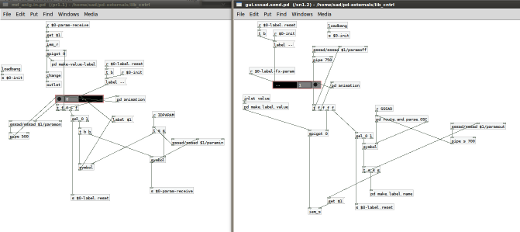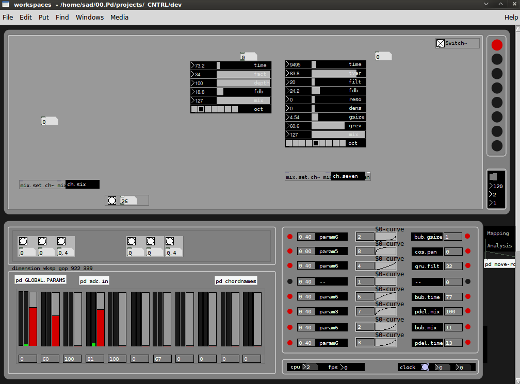Workflow improvements, an efficient router for MMG data mapping
Richness of colour and sophistication of form.
How to achieve a seamless interaction with a digital framework for DSP which can guarantee richness and sophistication in real time?
Moreover, the interaction I point at is a purely physical one.
Gesture to sound, this is the basic paradigm which I need to explore.
This is a fairly complex issue, as it requires a multi-modal investigation which encompasses interrelated areas of study. The main key points can be summarized as follow:
- developing a musical aesthetic by which appropriate DSP techniques can be conceived;
- coding relevant audio processing algorithms for muscle sounds;
- analysing and understanding the more appropriate gestures to be performed;
- train my muscles in order to learn how to efficiently execute specific gestures;
- developing a mapping system of kinetic energy to control data.
Drawing from this observations a roadmap for a further implementation of the Xth Sense framework, I found myself struggling with a practical issue: the GUI I was developing did not fit my needs, thus slowing down the whole composition process.
In order to comfortably concentrate on composition and design of the performance I needed an immediate and intuitive routing system, which would allow me to map any of the MMG control values available to any of the DSP parameter controls in use.
Such router would satisfy a twofold mapping: one-to-one and one-to-many.
In Pure Data control parameters can be distributed in several ways, however the main methods are by-hand chords connection and chord-less communication exploiting [send] and [receive], or OSC objects.
Obviously, I first excluded the implementation of a by-hand connection method, as I need to freely perform several muscle contractions in order to test the features extracted by the system in real time. A chord-less method would have better fit my needs, but still it did not satisfy me completely, as I wanted to route the MMG control values around my DSP framework fast and intuitively.
The sssad lib by Frank Barknecht coupled with the send/receiver [iem_s] and [iem_r] from IEMlib eventually stand out as a good solution.
sssad is a very handy and simply implemented abstraction which handles presets saving within Pd by means of a clear message system. [iem_s] and [iem_r] are dynamically settable sender/receiver included in the powerful iemlib by Thomas Musil at IEM, Graz Austria. I coupled them into 2 new macro send/receive abstractions which eventually allowed me to route any MMG control value to any DSP control parameter with 4 clicks (in Run mode).
Click to enlarge.
Four clicks routing:
1st – click a bang to select which source control value has to be routed.
2nd – activate one of the 8 inputs within the router; it will automagically set that port to receive values from the previously selected source
3rd – touch the slider controlling the DSP parameter control you want to address
4th – activate one of the 8 outputs within the router; it will automagically set that port to send values to the selected parameter.
This system works efficiently both for one-to-one and one-to-many data mapping. The implementation of such data mapping system dramatically improved the composition workflow; I can now easily execute gestures and immediately prototype a specific data mapping.
Besides, as you can see from the image above, I included a curve module, which enable the user to change on the fly the curve to be applied to the source value, before it get sent to the DSP framework.
The mapping abstractions are happily embedded in the major sssad preset system, thus all I/O parameters can be safely stored and recalled with a bang.
Heading picture CC licensed by Kaens.




